We can recognize the effects of climate change through melting ice and changing sea levels. We can see the struggles of animals whose habitat becomes uninhabitable to them due to climate change. But there are some voices that are harder to hear. Dutch biologist and "awareness artist" Thijs Biersteker has teamed up more than once with Italian scientist Stefano Mancuso to create interactive and immersive installations that translate the hard to hear voices of trees "speaking" about climate change into a language that is more easily heard and understood.
Voice of Nature
In 2018, using data from living trees, they created an installation called "The Voice of Nature." The idea of the installation was this:
“Trees and their tree rings are data capsules showing the change in climate happening over the years...we don’t have time to wait years for this data. It’s time to speed up the process to a human pace and show with data what nature is trying to tell us.”
Biersteker accomplished this by attaching different sensors to the tree and using the data-driven system developed by Stefano Mancuso, a founder in the study of plant neurobiology, which explores signaling and communication at all levels of biological organization, from genetics to molecules, cells, and ecological communities. Using real-time data coming from sensors attached to a tree, the art generates a tree ring every second from 1,600 data points, creating a real-time visualization of the conditions the tree is currently experiencing.
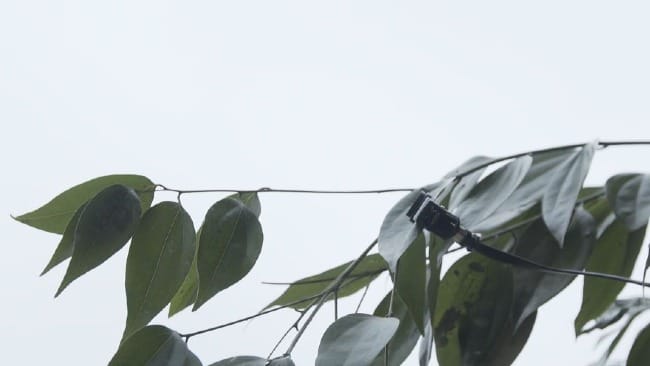
The rings indicate the tree’s state of well-being and the effect environmental changes are having as they occur. Trees produce records of good years and bad years, including environmental changes, disease, forest fires, droughts, and pollution levels through the thickness and shape of its tree rings. In this installation, the tree rings are electronic and appear on a giant screen behind the tree, indicating the current growth of the tree second-by-second rather than year-by-year.
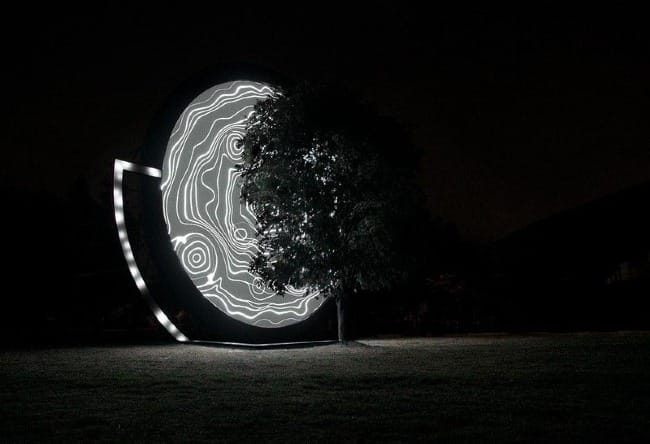
The sensors measure things such as soil temperature, moisture levels, air quality, and CO2 levels. The effects of increased pollution or decreased light can be seen immediately on the giant screen behind the tree, "giving nature a faster voice in a time where climate change is moving faster and faster." 1 The color of the exhibit changes according to the sensor inputs; a traffic jam near the tree can cause the entire visualization to turn red due to increased CO2 levels.
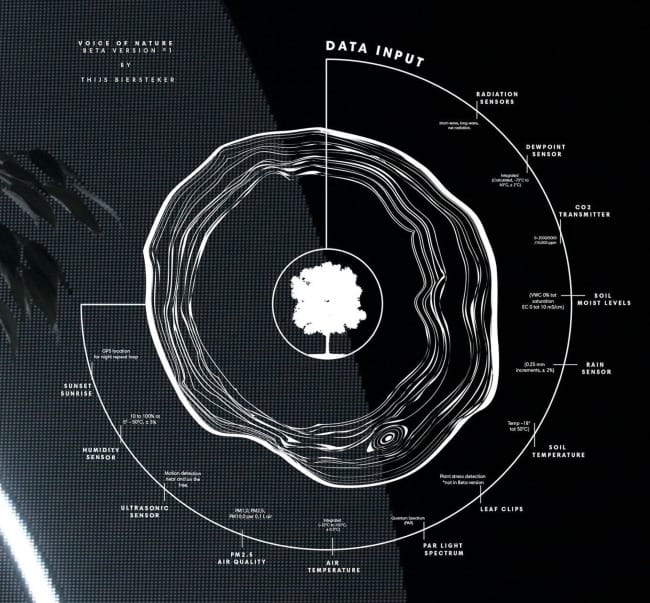
Voice of Nature shows in a poetic way the large influence humanity has on the changing climate. If someone touches the tree, it affects the tree's response, either calming the image on the screen or increasing the energy levels, thereby communicating the message to spectators (and participants) that they have power to enact change.
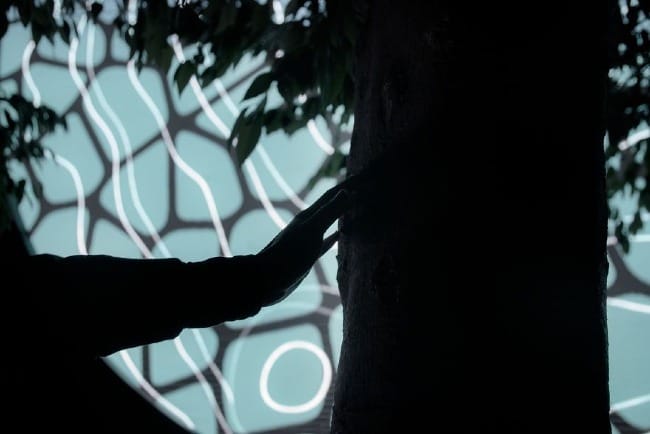
Biersteker tells a story that demonstrates the ability of the art installation to initiate action.
“During the build-up of the installation it had not been raining for a while so we asked if someone could water the tree, but everyone was busy. Once we connected our moist level sensor to the tree and showed the data indicating the tree was thirsty, there was someone with a water hose within 15 minutes."
Symbiosia
In 2019, again in collaboration with Stefano Mancuso, Biersteker created another installation, Symbiosia, originally part of a larger exhibit located in Paris called, Trees.
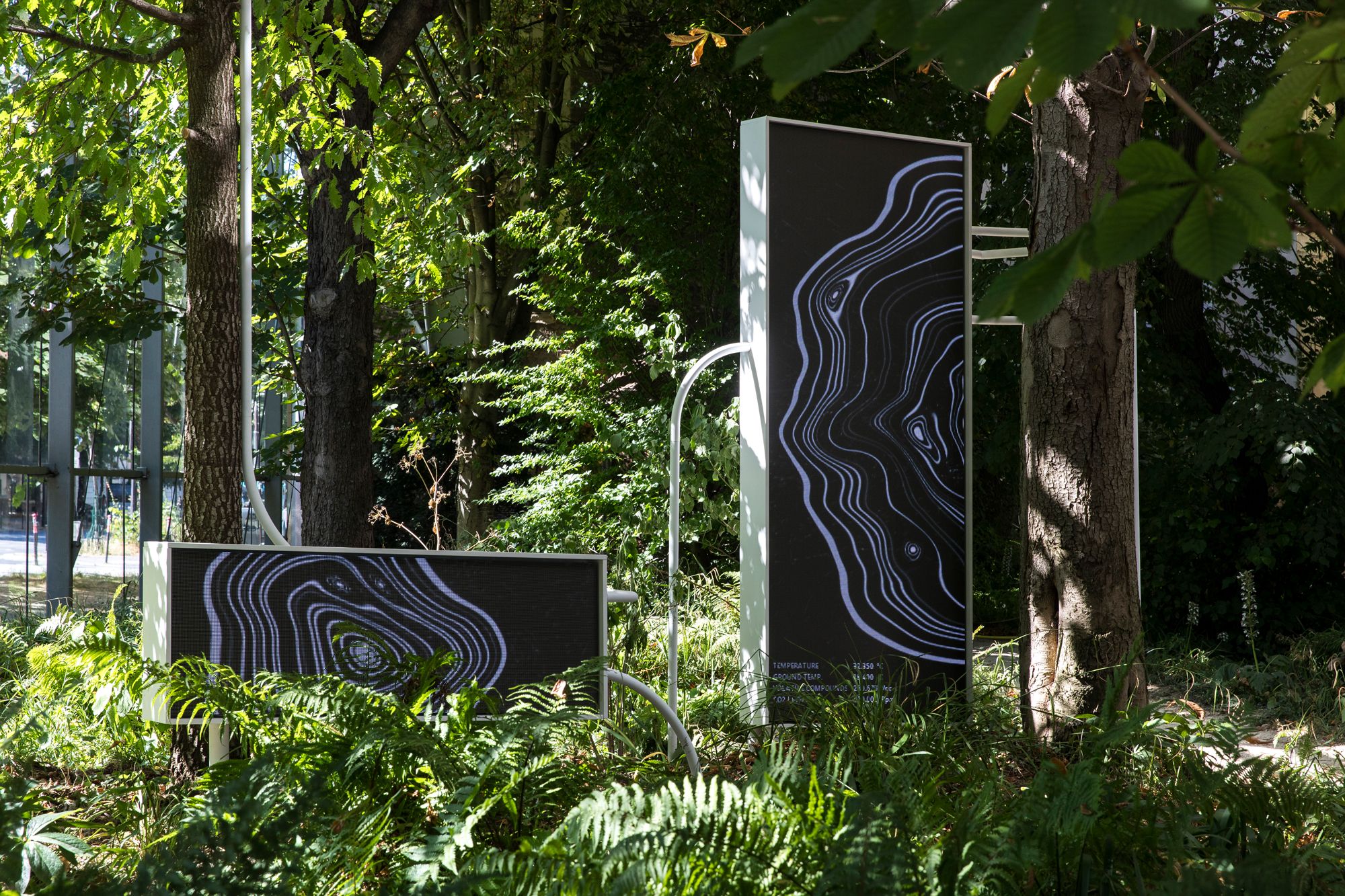
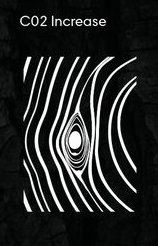
The two connected trees of the Symbiosia exhibit beside their respective tree rings and a close up of the change created by an increase in CO2
Drawing on Mancuso's work in communication between trees, including root communication and the idea of plant memory, this work addressed the relationship of trees with people, the environment and each other.
A data-driven system estimates the real-time impact of climate change on the local environment. Traffic jams that raise the CO2 levels and droughts caused by higher summer temperatures all have an instantaneous effect on the "tree circles" produced by the installation.
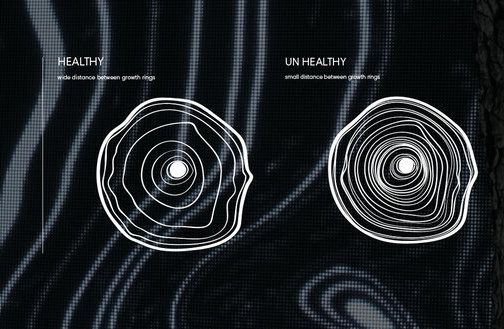
Comparison of healthy and unhealthy rings generated by the tree
For the installation (which has become a traveling exhibit after Paris), digital roots are created between two living trees, (in Paris, a horse chestnut and a Turkey oak) and 12 sensors are placed on the two trees and their branches, through which changes in the trees' photosynthesis, the air quality and chemical air compounds are measured. The sensors collect the data, which are used to produce data visualization in the form of electronic tree rings. This mixture of art and science translates hard data into an accessible form that people can often better understand and relate to.
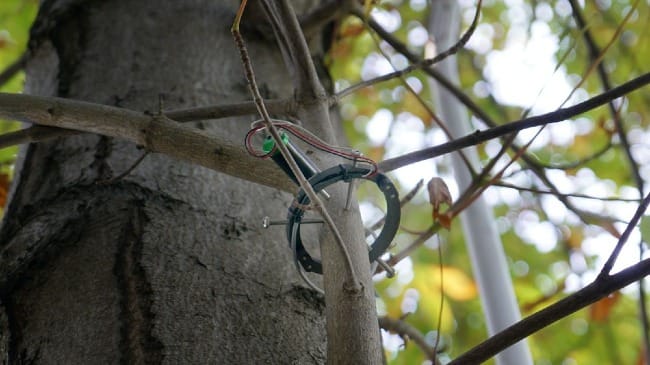
By showing the sensitivity and activity of the trees and the environmental impacts affecting them, Biersteker aims to nurture a stronger symbiotic relationship between humanity and nature (thus the title of the piece). In this mind, this is the only way forward to co-exist on this planet.
Both of these installations work to both bring climate change more into our awareness. It may be possible to think that melting ice and rising sea levels are happening "somewhere else," but trees and other plants are ubiquitous and thus, harder to discount. As Biersteker says, "Many of the ecological disasters happening right now are hard to imagine; they feel big and distant, or they happen somewhere not visible for our eyes, in the midst of the ocean or rainforest. I want to turn these complex problems into relatable experiences. If I can give people a personal experience with one of these issues, it might create empathy, that can turn into activism, that possibly in the end contribute to change."2
It can also help people see that their actions matter. “Phrases like climate change or "anthropocene" feel so out of reach. What I try to do is make it tangible at that moment. In the longer spectrum, a lot of people don’t connect to the issues because they become too big. I want to make them small again, so you have the idea that you can act. It’s happening at your time, not the next generation.” 3
When we shift and see climate change as something happening to the tree in our backyard as well as the polar bear in the arctic, that can affect the urgency we feel around the issue. And when we have a picture in our minds of the way our small actions can have large ripple effects, not just negative, but positive as well, that can give us the energy to choose specific actions—such as choosing to walk somewhere rather than drive.
Reflection Questions: Do you see climate change as something nearby or something distant from you? What enables you to take small (or big) actions in the face of a very large problem? Have you ever brainstormed a list of actions you might take to create a positive ripple effect on climate change?
If you want to learn more about Thijs Biersteker or Stefano Mancuso, both have done intriguing TED Talks.
Louise
I would love to hear from you at info@circlewood.online or through the comment section below.
